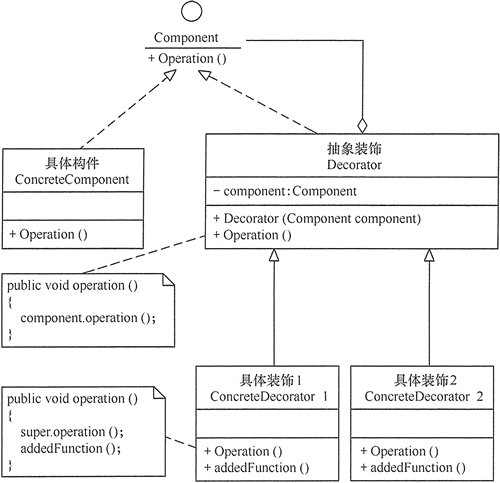定义:在不改变对象结构的情况下,动态地给该对象增加一些职责(即额外功能)的模式。
一. 结构图
抽象构件:规范准备接收附加责任的对象。
具体构件:定义一个将要接收附加责任的类。
抽象装饰:持有一个构件(Component)对象的实例,并实现一个与抽象构件接口一致的接口。
具体装饰:负责给构件对象添加上附加的责任。

二 . 实现
package decorator; public class DecoratorPattern { public static void main(String[] args) { Component p=new ConcreteComponent(); p.operation(); System.out.println("---------------------------------"); Component d=new ConcreteDecorator(p); d.operation(); } } //抽象构件角色 interface Component { public void operation(); } //具体构件角色 class ConcreteComponent implements Component { public ConcreteComponent() { System.out.println("创建具体构件角色"); } public void operation() { System.out.println("调用具体构件角色的方法operation()"); } } //抽象装饰角色 class Decorator implements Component { private Component component; public Decorator(Component component) { this.component=component; } public void operation() { component.operation(); } } //具体装饰角色 class ConcreteDecorator extends Decorator { public ConcreteDecorator(Component component) { super(component); } public void operation() { super.operation(); addedFunction(); } public void addedFunction() { System.out.println("为具体构件角色增加额外的功能addedFunction()"); } }
三. 应用场景
1. 需要给一个类添加职责,但不能通过派生子类实现。例如:该类被隐藏或该类是终极类或采用继承方式会产生大量的子类。[不允许派生]
2. 需要对现有一组基本功能,进行排列组合而产生非常多的功能时,采用继承关系很难实现,而采用装饰模式却很好实现。[排列组合]
3. 对象的功能被要求可以动态添加和撤销时。[动态新增和撤销]
四. 优缺点
优点: 扩展对象的功能比继承方式更加灵活。 可以设计出多个不同的具体装饰类,创造出多个不同行为的组合。
缺点:增加了许多子类会增添程序复杂性。
五. 实例
